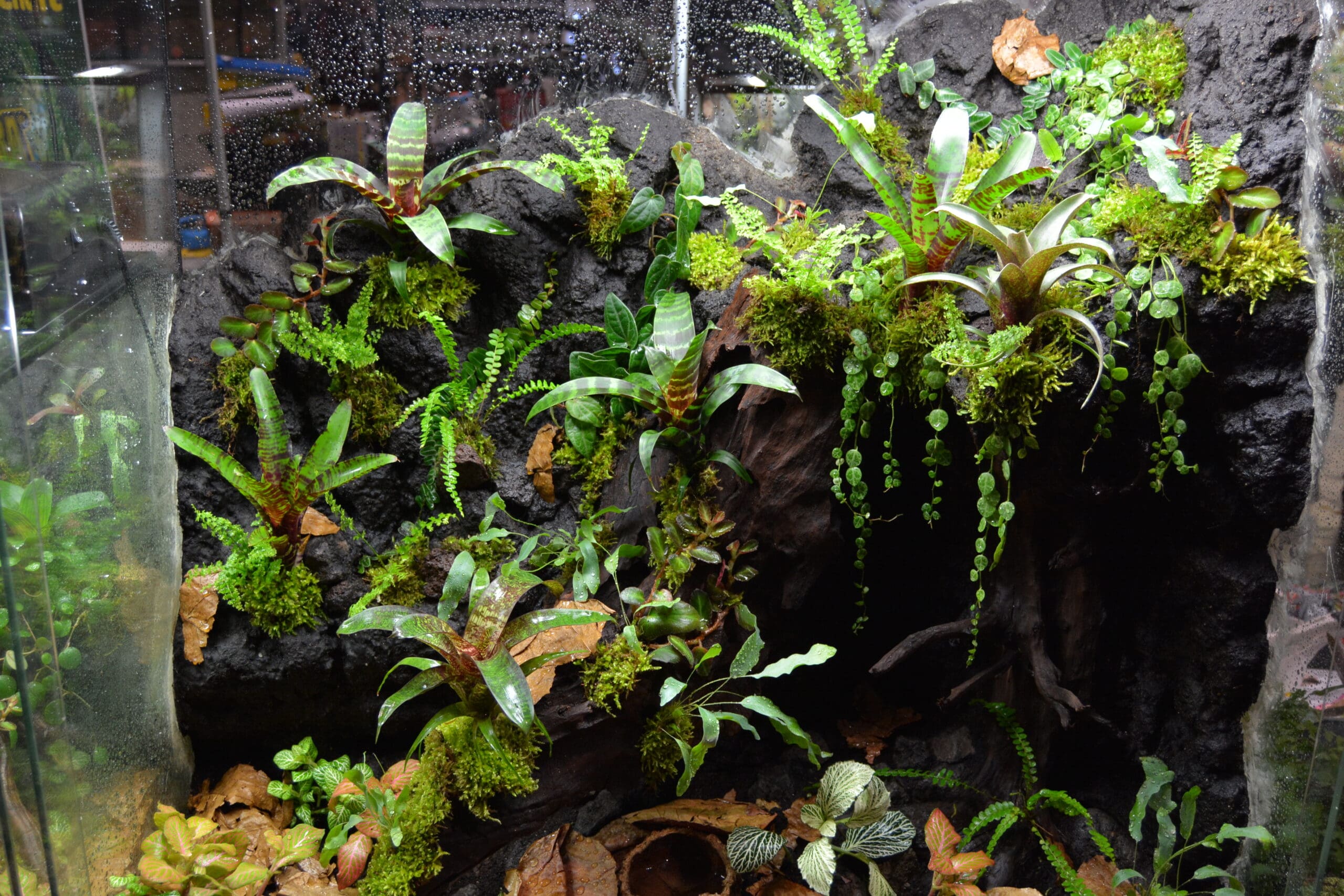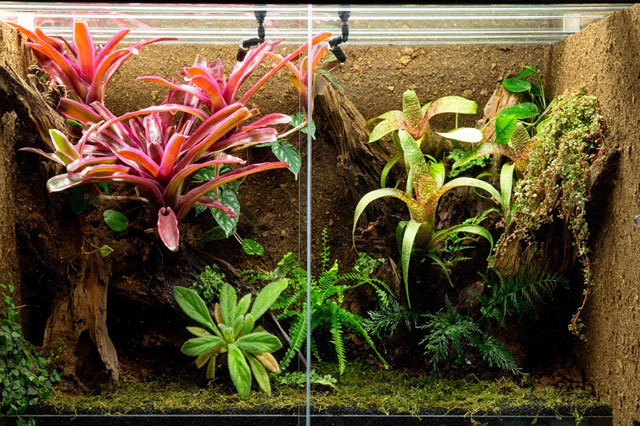Bioactive terrariums are self-sustaining ecosystems that house both plants and animals. They require minimal maintenance due to their natural balance.
Bioactive terrariums mimic natural habitats, creating a balanced ecosystem within an enclosure. They incorporate live plants, beneficial microorganisms, and small animals like reptiles or amphibians. These elements work together to break down waste, promote plant growth, and maintain humidity levels.
The result is a visually appealing, low-maintenance environment that supports the health and well-being of its inhabitants. Bioactive terrariums are increasingly popular among pet owners and hobbyists, offering a sustainable and engaging way to observe natural processes. With proper setup, they become thriving mini-ecosystems that require minimal intervention, making them ideal for busy individuals.

Credit: exo-terra.com
Introduction To Bioactive Terrariums
Bioactive terrariums are gaining popularity among reptile and amphibian enthusiasts. These setups mimic natural ecosystems, creating a self-sustaining environment. Let’s explore what makes them unique and beneficial.
What Is A Bioactive Terrarium?
A bioactive terrarium is a self-sustaining habitat for pets. It includes live plants, beneficial insects, and microorganisms. These elements work together to maintain the environment.
The key components of a bioactive terrarium are:
- Substrate: A mix of soil, sand, and other materials.
- Plants: Live plants that suit the habitat.
- Microfauna: Tiny organisms like springtails and isopods.
- Cleanup Crew: Insects that help break down waste.
Benefits Of Bioactive Terrariums
There are several benefits to setting up a bioactive terrarium:
- Natural Waste Management: The cleanup crew breaks down waste, keeping the habitat clean.
- Reduced Maintenance: Less frequent cleaning needed, thanks to the self-sustaining system.
- Healthier Pets: A natural environment promotes better health and behavior.
- Enhanced Aesthetics: Live plants and natural elements create a beautiful display.
Bioactive terrariums create a healthier and more engaging environment for your pets. They also reduce the effort needed to maintain the habitat.
Essential Components
Creating a thriving bioactive terrarium requires understanding its essential components. Each part works together to form a balanced ecosystem. This section covers the most crucial elements.
Substrate Layers
The substrate layers are the foundation of your bioactive terrarium. These layers provide support for plants and a home for microorganisms. Here’s a simple table to show the layers:
| Layer | Function |
|---|---|
| Drainage Layer | Prevents waterlogging |
| Barrier Layer | Separates soil and drainage |
| Substrate Layer | Supports plant roots |
Microfauna And Clean-up Crew
Microfauna and clean-up crew are tiny organisms that keep your terrarium healthy. These creatures break down waste and keep the environment clean.
- Springtails: These tiny insects eat mold and fungi.
- Isopods: Also known as pill bugs, they consume decaying material.
- Worms: They aerate the soil and help with decomposition.
Having a diverse clean-up crew ensures that waste is quickly broken down. This keeps the terrarium clean and healthy.
Choosing Plants
Choosing the right plants is essential for a thriving bioactive terrarium. The plants not only enhance the visual appeal but also contribute to the ecosystem’s health. This section will guide you through selecting suitable plant species and caring for them.
Suitable Plant Species
Selecting the appropriate plants can be daunting. Here are some excellent choices:
- Pothos (Epipremnum aureum): Hardy and versatile, perfect for beginners.
- Ferns: Ideal for creating a lush, green look.
- Bromeliads: Adds a splash of color and thrives in humid conditions.
- Spider Plants (Chlorophytum comosum): Easy to care for and resilient.
- Peperomia: Requires minimal care and offers a variety of textures.
Plant Care Tips
Proper plant care ensures a healthy bioactive terrarium. Follow these tips:
- Light: Ensure plants receive adequate but indirect light.
- Water: Keep the soil moist but avoid overwatering.
- Humidity: Maintain high humidity levels for tropical plants.
- Soil: Use a well-draining substrate to prevent root rot.
- Pruning: Regularly trim plants to prevent overgrowth.
| Plant | Light Requirements | Watering Needs |
|---|---|---|
| Pothos | Low to moderate | Moderate |
| Ferns | Low to moderate | High |
| Bromeliads | Moderate to bright | Moderate |
| Spider Plants | Moderate | Moderate |
| Peperomia | Low to moderate | Low to moderate |
Selecting Inhabitants
Choosing the right inhabitants for your bioactive terrarium is crucial. The right balance creates a thriving ecosystem. Let’s explore the types of inhabitants and their compatibility.
Types Of Inhabitants
Various creatures can live in a bioactive terrarium. Here are some common types:
- Reptiles: Geckos, anoles, and small snakes thrive in these environments.
- Amphibians: Frogs, salamanders, and newts enjoy moist conditions.
- Invertebrates: Isopods and springtails help break down waste.
- Plants: Ferns, mosses, and bromeliads add greenery and oxygen.
Compatibility And Coexistence
It’s essential to ensure that all inhabitants can coexist peacefully. Follow these tips:
- Research: Investigate the needs of each species.
- Space: Provide enough room for all creatures.
- Diet: Ensure diets do not conflict.
- Behavior: Avoid aggressive species.
Here’s a quick compatibility table:
| Inhabitant | Compatible Species | Notes |
|---|---|---|
| Geckos | Isopods, Springtails | Avoid housing with larger reptiles. |
| Frogs | Springtails, Plants | Need high humidity. |
| Isopods | Most reptiles and amphibians | Great for waste management. |
Creating The Perfect Environment
Creating the perfect environment for a bioactive terrarium is essential. This ensures your plants and animals thrive. Several factors contribute to a balanced ecosystem. These include lighting, humidity, and temperature control. Each element plays a crucial role in maintaining a healthy terrarium.
Lighting Requirements
Lighting is vital for a bioactive terrarium. Proper light ensures plant growth and animal health.
Here are some lighting options:
- LED lights: Energy-efficient and long-lasting.
- UVB lights: Essential for reptiles and amphibians.
- Fluorescent lights: Affordable and effective.
Ensure your terrarium receives 10-12 hours of light daily. This mimics natural daylight cycles. Adjust light intensity based on plant and animal needs.
Humidity And Temperature Control
Humidity and temperature are crucial for a thriving terrarium. Different species have unique requirements.
Here are some general guidelines:
| Species | Humidity | Temperature |
|---|---|---|
| Frogs | 70-90% | 75-85°F |
| Geckos | 50-70% | 75-85°F |
| Plants | 60-80% | 70-80°F |
Use a hygrometer to monitor humidity levels. Mist the terrarium regularly to maintain moisture. Install a thermometer to keep track of temperature. Heat lamps or pads can help regulate warmth.
Creating a balanced environment ensures the health of your terrarium. Proper lighting, humidity, and temperature control are key factors. Pay attention to these elements for a thriving bioactive terrarium.

Credit: sierrafishandpets.com
Maintaining Balance
Maintaining balance in a bioactive terrarium is essential. A healthy ecosystem inside your terrarium ensures the well-being of plants and animals. This section will guide you on how to keep this delicate balance intact.
Monitoring Ecosystem Health
Regularly check your terrarium’s ecosystem health. Watch for signs of overgrowth or decay.
- Plants: Ensure plants look vibrant and healthy. Remove any dead leaves.
- Animals: Observe animals’ behavior and activity levels. They should seem active and alert.
- Substrate: Check for mold or unpleasant odors. Replace or clean as needed.
Use a hygrometer to monitor humidity levels. Keep a thermometer to check temperature regularly. Record these readings in a journal.
Troubleshooting Common Issues
Bioactive terrariums can face issues. Knowing how to address them ensures longevity.
| Issue | Solution |
|---|---|
| Mold Growth | Improve ventilation and reduce humidity levels. |
| Pest Infestation | Introduce predatory insects or clean the affected area. |
| Plant Wilt | Check soil moisture and adjust watering habits. |
| Animal Lethargy | Ensure proper diet and environmental conditions. |
Keep an eye on these common issues. Swift action can prevent bigger problems.
Decor And Aesthetics
Creating a bioactive terrarium involves more than just keeping pets. The decor and aesthetics play a crucial role. A well-decorated terrarium replicates natural habitats. It looks beautiful and benefits the inhabitants.
Natural Decorations
Natural decorations enhance the terrarium’s beauty. They also provide a functional habitat.
| Item | Purpose |
|---|---|
| Rocks | Provide hiding spots and climbing areas |
| Branches | Offer climbing structures and natural look |
| Live Plants | Purify air and create a natural environment |
Design Tips For Visual Appeal
Follow these tips to make your terrarium visually appealing:
- Use different levels: Create layers with rocks and branches.
- Mix textures: Combine smooth stones with rough wood.
- Add color: Choose plants with varying shades of green.
- Maintain balance: Ensure decorations are not overcrowded.
Long-term Care
Long-term care is essential for maintaining healthy bioactive terrariums. Proper care ensures the ecosystem thrives over time.
Routine Maintenance
Routine maintenance is key for the health of your bioactive terrarium. Here are some tips:
- Watering: Water plants regularly. Ensure the soil stays moist.
- Cleaning: Remove dead leaves and debris. Keep the terrarium clean.
- Feeding: Feed the animals appropriately. Check diet requirements.
Adapting To Changes
Adapting to changes is crucial for long-term success. Monitor and adjust as needed:
- Temperature: Check the temperature often. Adjust to maintain optimal conditions.
- Humidity: Keep the humidity levels stable. Use a hygrometer to monitor.
- Lighting: Provide adequate light. Adjust based on plant and animal needs.
| Aspect | Action | Frequency |
|---|---|---|
| Watering | Water plants | Weekly |
| Cleaning | Remove debris | Weekly |
| Feeding | Feed animals | Varies |
| Temperature | Monitor and adjust | Daily |
| Humidity | Check and maintain | Daily |
| Lighting | Adjust light | Daily |

Credit: terrariumtribe.com
Conclusion
Creating a bioactive terrarium offers a natural, self-sustaining habitat for your pets. It’s an engaging and educational hobby. By setting up this ecosystem, you promote healthier living conditions for your reptiles or amphibians. Start your bioactive terrarium journey today and enjoy a thriving, miniature world right in your home.
